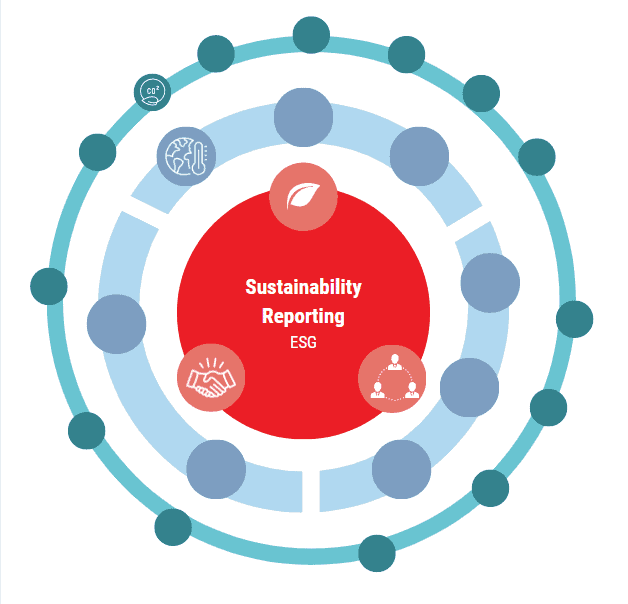The Corporate Sustainability Reporting Directive (CSRD) is impacting companies in a significant way. As reporting organizations are working to assess the impact of the Directive, we receive an increased number of questions on where to start the journey to become CSRD-compliant. CSRD requires large companies and certain public-interest entities to disclose information on their ESG impacts in their annual reports. This extensive package is aimed at driving companies in their sustainability journey. The materiality assessment remains the key to identify reporting topics, however CSRD introduces a set of new principles to assess materiality. In this blog, we help you get started with sustainability reporting, starting off with the double materiality principles of a 3-part mini-series.
Double materiality: key concepts
Double materiality is defined by the European Financial Reporting Advisory Group (EFRAG) as follows: companies should report on traditional impact materiality, as introduced by the Global Reporting Initiative (GRI), as well as financial impact materiality. As a result, companies should not only report their financial performance, but also the environmental, social, and governance impacts of their operations that could affect their financial performance in the long term.
To help you get started with sustainability reporting, we will share our experience and best practices in a 3-part mini-series.
Our best practices: step by step
Identifying stakeholders: identifying the stakeholders of your organization is the crucial first step in the materiality assessment process. Your stakeholder lists determines which stakeholders you will engage in the next steps of the materiality analysis. Your stakeholders will verify your material topics and determine the legitimacy of your sustainability report. Stakeholders include groups or individuals that are affected by your company’s operations or who have the power to influence your company’s operations. Examples of stakeholders include shareholders, customers, employees, suppliers, and local communities.
Identifying long list of topics: an important starting point is the long-list of potential material topics. Current sustainability reporting, market analysis, media scans, stakeholder input, and expert knowledge is recommended to be used as input to create your long list of topics. Each topic should be delivered with a clear definition in the context of your organization. Relevant stakeholders, as identified in the previous step, are to be matched with their relevant topic.
Value creation model: Value is created through your organization’s business model, which takes inputs from the capitals and transforms them through business activities and interactions to produce outputs and outcomes that, over the short, medium and long term, create or destroy value for your organization, its stakeholders, society and the environment.
Although organizations aim to create value overall, resources and relationships, also referred to in the Draft Framework as different types of “capital”, may be destroyed or depleted in the process of conducting business activities. Therefore, whenever the term “value creation” is used, it should be interpreted to include actual or potential value destruction or depletion. The Value Creation Model is thus not only a strong framework on its own, but also a valuable tool in de materiality assessment
We will take a deep dive into the value creation in another blog post of this series “how to start with sustainability reporting”!
Assess double materiality: Double materiality differentiates itself from the traditional materiality assessments by the newly introduced concept of financial materiality. Note, financial materiality in the sustainability reporting context does not have the same definition as the financial materiality in the financial reporting context. A sustainability topic is material from a financial perspective if it triggers financial effects on undertakings. For example, it generates risks or opportunities that influence or are likely to influence the future cash flows and therefore the enterprise value of the undertaking in the short, medium or long term (but are not captured by traditional financial reporting). These risks and opportunities may derive from past events or future events and may have effects on future cash flows, also known as “triggers”. Besides the financial materiality, the impact materiality needs to be assessed likewise. Impact materiality is known as the classic definition of materiality in sustainability reporting. It includes three parameters: scale; scope; and remediability of impact.
Topics that are either financial material, impact material or both are required to be included in the report.

Visualize your materiality assessment: Finally, the materiality assessment and short list of topics need to be visualized. Because the principles of materiality have changed with the introduction of double materiality – the traditional “materiality matrix” does not cover the analysis anymore. Front-runners are experimenting with new methods to visualize their materiality assessment, for instance network visualization.
Is your organization ready to further their sustainability reporting? Don’t hesitate to contact us. We are more than happy to discuss how we can support you in your journey to make sustainability business as usual!
By following these first steps, you ensure that value is created alongside with your sustainability reporting journey. And ensures you’re reporting in accordance to the CSRD and principles of double materiality.


